|
The
Tuamotus
May 2002
 We
have definitely arrived in Tropical Paradise. The Marquesas were
volcanically dramatic and spectacular, but the Tuamotus are laid-back blue
lagoons. These are coral atolls, ancient volcanoes where the
gradually-sinking cone has been surmounted by coral reefs. The cone is no
longer in evidence, just lovely blue lagoons. Imagne a 30 by 15 mile
salt-water lake, about 100 feet deep, surrounded by a string of narrow
islands the Polynesians call motus. We
have definitely arrived in Tropical Paradise. The Marquesas were
volcanically dramatic and spectacular, but the Tuamotus are laid-back blue
lagoons. These are coral atolls, ancient volcanoes where the
gradually-sinking cone has been surmounted by coral reefs. The cone is no
longer in evidence, just lovely blue lagoons. Imagne a 30 by 15 mile
salt-water lake, about 100 feet deep, surrounded by a string of narrow
islands the Polynesians call motus.
There is
usually just one pass into each atoll, with strong tidal currents that
reverse four times a day. This means timing our arrival for slack tide to
go through the pass. If you consider that we must also leave the previous
atoll at slack tide and at a time when the sun is overhead for good
visibility, sail a hundred or so miles to the next island and arrive at
the next slack tide, the navigator has his work cut out for him. We were
quite worried about getting through our first pass, since there is always
a current running and sometimes waves. So far the passes have been clearly
marked and there are lots of other cruisers willing to offer assistance
over the radio.
 The water
in the Tuamotus is azure blue over white sand and coral heads, unlike the
black volcanic sand of the Marquesas. We prefer the white stuff. The
snorkeling and diving are superb, if you can get past the fact that there
are always sharks around. Jan can, I can’t. In Makemo, the water was so
clear and shallow under the boat that we could clearly see our own anchor
and chain. We also had our own personal coral heads under the boat with
lots of fish. The water is ankle deep at low tide along the edge of the
ocean reef, so there is tide pool exploring and fish and lobster catching
to be done. The water
in the Tuamotus is azure blue over white sand and coral heads, unlike the
black volcanic sand of the Marquesas. We prefer the white stuff. The
snorkeling and diving are superb, if you can get past the fact that there
are always sharks around. Jan can, I can’t. In Makemo, the water was so
clear and shallow under the boat that we could clearly see our own anchor
and chain. We also had our own personal coral heads under the boat with
lots of fish. The water is ankle deep at low tide along the edge of the
ocean reef, so there is tide pool exploring and fish and lobster catching
to be done.
Makemo
Getting to
our first Tuamotu atoll wasn’t the easiest part, as we had to sail more
than 500 miles from Nuku Hiva to Makemo. This turned out to be a
combination of boring and irritating motoring for two days, followed by
gusty winds and confused seas on the beam for the final day. We got banged
around a bit and it wasn’t very comfortable sometimes, but the main
problem was going slow enough when the wind blew, as Raven likes to move
along smartly and hates to be slowed down. We had to reef the main and
roll up the jib to get her down to five knots, and still we arrived at the
Makemo pass too early. We hove to (to “heave to” means to set the sails so
that the boat just drifts slowly, quietly, and safely downwind) for a
couple of hours and went through our first Tuamotu pass with three knots
of current against us and no problems at all.
 At Makemo,
the only family living at the east end of the lagoon adopted us and the
other cruisers nearby. The first night we – 15 cruisers from 7 boats
anchored there – hosted Jean-Marie, Emilianne and their three little kids
to a potluck dinner. Since we are all out of fresh food, there was lots of
pasta salad, couscous, rice and beans, and brownies, etc. The family
seemed pleased, although we’re not sure what they thought of all the
“exotic” flavors like salsa, chili, curry, and chocolate pudding. They
told us about their life on the motu At Makemo,
the only family living at the east end of the lagoon adopted us and the
other cruisers nearby. The first night we – 15 cruisers from 7 boats
anchored there – hosted Jean-Marie, Emilianne and their three little kids
to a potluck dinner. Since we are all out of fresh food, there was lots of
pasta salad, couscous, rice and beans, and brownies, etc. The family
seemed pleased, although we’re not sure what they thought of all the
“exotic” flavors like salsa, chili, curry, and chocolate pudding. They
told us about their life on the motu
 making copra to sell, which
family members own which parts of the motu, etc., etc. Three of the guys
even spent a morning cutting brush and collecting coconuts with
Jean-Marie. Hot, sweaty work, but the French government is subsidizing
copra production these days to help people make a living on the outer
islands. Apparently, that’s a lot cheaper than solving all the problems
caused by people moving into Papeete in search of work. making copra to sell, which
family members own which parts of the motu, etc., etc. Three of the guys
even spent a morning cutting brush and collecting coconuts with
Jean-Marie. Hot, sweaty work, but the French government is subsidizing
copra production these days to help people make a living on the outer
islands. Apparently, that’s a lot cheaper than solving all the problems
caused by people moving into Papeete in search of work.
Jean-Marie
took several other cruisers out to fish at low tide by lying in tide pools
on the coral reef and spearing the fish hiding under the rocks. This was
slightly easier than the lobstering technique, which involved going out at
low tide in the middle of the night after moonset with a Coleman gas
lantern, walking along the reef for several miles and mesmerizing the
lobsters with the light. Then they were easy to pick up. At least it was
easy for Jean-Marie. He caught 25 lobsters while the three Americans
caught two, all of which Jean-Marie pointed out to them! Maybe you just
have to be born here.
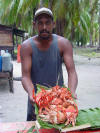 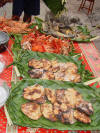 After the
Great Lobstering Expedition, Jean Marie and his wife prepared a Tuamotuan
feast for all of us cruisers. They boiled the lobsters in a big pot over
an open fire, steamed fish in a pit over hot coral rocks, and baked
coconut bread made from the interior of the coconut when it has started to
sprout. Remember, this was a very young couple with three children who
were living in a corrugated tin shack working their family’s copra
plantation. They had very little, but were willing to share the bounty of
their atoll with us. We were able to give them some practical gifts like
rope, a big bucket with a lid, some children’s clothes and toys, Ziploc
bags (Emilianne loved those!), and adhesive to caulk their leaking
motorboat. After the
Great Lobstering Expedition, Jean Marie and his wife prepared a Tuamotuan
feast for all of us cruisers. They boiled the lobsters in a big pot over
an open fire, steamed fish in a pit over hot coral rocks, and baked
coconut bread made from the interior of the coconut when it has started to
sprout. Remember, this was a very young couple with three children who
were living in a corrugated tin shack working their family’s copra
plantation. They had very little, but were willing to share the bounty of
their atoll with us. We were able to give them some practical gifts like
rope, a big bucket with a lid, some children’s clothes and toys, Ziploc
bags (Emilianne loved those!), and adhesive to caulk their leaking
motorboat.
 While we
were waiting for the party to begin, a huge squall came through the
anchorage. There we all were, stuck on shore and watching our floating
homes disappear from view into the 30-knot winds and rain while we stood
helpless in a corrugated tin copra storage shack. The shack hadn’t been
used in some time. The resident ants started swarming to get out of the
wet, and we were covered in flies trying to stay dry too. It was one of
the times when we had to think, “What the heck are we doing here?” But the
squalls died down, the balmy breezes came back, none of the boats dragged
anchor, and all was well. While we
were waiting for the party to begin, a huge squall came through the
anchorage. There we all were, stuck on shore and watching our floating
homes disappear from view into the 30-knot winds and rain while we stood
helpless in a corrugated tin copra storage shack. The shack hadn’t been
used in some time. The resident ants started swarming to get out of the
wet, and we were covered in flies trying to stay dry too. It was one of
the times when we had to think, “What the heck are we doing here?” But the
squalls died down, the balmy breezes came back, none of the boats dragged
anchor, and all was well.
Provisioning in remote
places
Food
shopping here is an Experience. We were warned that there was very little
available in these islands, so most of us tried to provision in Mexico for
three months. We all planned to stay in the islands that long before
hitting the grand metropolis of Papeete in Tahiti. There is usually at
least one store on each atoll, if it is inhabited (many are not). Weekly
cargo ships bring basic supplies to all the atolls: sugar, flour, canned
corned beef, peanut butter (!!!), beer, pop, and a few canned goods. Oh,
and they always have Pringles in six flavors. There are virtually
no fresh fruits or vegetables. Every once in awhile, an onion or a few
potatoes show up, then we all have the guilts about whether to grab them
up or to leave them for the locals.
The other
day in Makemo we found a baggy of actual lettuce and gave in to the
temptation to buy it, even though the price was $6.40 for a few leaves. At
least it was fresh. I dole out each leaf, believe me, but it does taste
good! In a later atoll, Fakarava, we were told that the store got new
vegetables by plane on Monday after 3 p.m. So we sat outside waiting for
the delivery from the airport of one small box each of lettuce, tomatoes,
carrots and cucumbers. Luckily we were there on time, because there was
nothing left by 3:15! Now we are embarking on The Great Egg Search. They
come by plane on Wednesday. Guess we will have to stand watch again.
Last
Thursday was Movie Night aboard Raven. Ten of us were perched in the
cockpit watching “When Harry Met Sally.” In the middle of the movie, Harry
and Sally were having an intense conversation in a restaurant, and Susan
of C’est la Vie spoke for all of us when she blurted out, “Heck
with the sex talk, I want some of that salad they’re eating!” On the radio
net one morning, after bemoaning their lack of success in finding fresh
veggies, Tom and Lynn of Roxanne burst into a spontaneous verse of
“Looking for Lettuce in All the Wrong Places”!
Pearls
In Makemo,
we also had our first Black Pearl Experience. These islands are known for
their pearl farms and everyone had told us to buy them here at the source,
not in Papeete, where the prices are astronomical. So we searched out
Frederic in the village, who had a small pearl farming operation behind
his house. His wife did all the delicate grafting of the nucleus into the
live oyster, doing fifty per day. She explained all about the fascinating
process while we watched, asked questions, and took photos.
Frederic
harvests his pearls three times a year, and the pearls grow in the shells
from 12-14 months. He usually harvests over 50,000 pearls a year! Yes,
it’s a mind-boggling number, and this was from a smallish operation. Other
atolls have huge commercial farms that ship everything directly to Tahiti.
We are told that the production has gotten so large that the prices are
dropping for the lower quality pearls, while prices for the top quality
ones have held up.
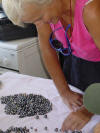  All we
know is that the next step in our visit was to have Frederic take us into
his home. He put a cheap plastic briefcase on the kitchen table, spread
out a cloth and poured out about 3,000 pearls. My friend, Susan of
C’est la Vie, and I got to sort and sift to our hearts’
content. There were many different colors: gold, grey, black, green, blue,
cream. And there were many different shapes and sizes – oval, ringed,
round, keeshee (irregular natural pearls without nuclei), and some really
strange, but beautiful “freaks.” Susan and I All we
know is that the next step in our visit was to have Frederic take us into
his home. He put a cheap plastic briefcase on the kitchen table, spread
out a cloth and poured out about 3,000 pearls. My friend, Susan of
C’est la Vie, and I got to sort and sift to our hearts’
content. There were many different colors: gold, grey, black, green, blue,
cream. And there were many different shapes and sizes – oval, ringed,
round, keeshee (irregular natural pearls without nuclei), and some really
strange, but beautiful “freaks.” Susan and I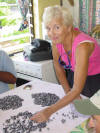 could have stayed there for
weeks, but the husbands were getting nervous about the negotiating process
to come. In the end, we counted up the pearls and Frederick came up with a
price. There was no discount for quantity, no premium for quality, just
one price for all and that was that. It was quite a bargain, considering,
so we all left happy. Especially Susan and I!! could have stayed there for
weeks, but the husbands were getting nervous about the negotiating process
to come. In the end, we counted up the pearls and Frederick came up with a
price. There was no discount for quantity, no premium for quality, just
one price for all and that was that. It was quite a bargain, considering,
so we all left happy. Especially Susan and I!!
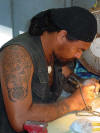 Next we
went to visit Bekko, who carves pearls, bone, and sperm whale teeth. At
first this seemed like a strange concept and a desecration of the pearls.
When we actually saw the result, it was quite intriguing. Bekko is covered
in Tahitian tattoos and carves similar Tahitian designs on each pearl with
a dental drill. How he can see that fine work, we don’t know. He also
carves very elaborate designs in sperm whale teeth, very much like
scrimshaw, but in more elaborate bas relief. These were
spectacular, but the prices he gets for them in Papeete are way beyond a
mere mortal’s price range. Bekko wanted to trade one carved tooth for our
night vision binoculars – these people are in remote islands, but
unsophisticated they are not! Next we
went to visit Bekko, who carves pearls, bone, and sperm whale teeth. At
first this seemed like a strange concept and a desecration of the pearls.
When we actually saw the result, it was quite intriguing. Bekko is covered
in Tahitian tattoos and carves similar Tahitian designs on each pearl with
a dental drill. How he can see that fine work, we don’t know. He also
carves very elaborate designs in sperm whale teeth, very much like
scrimshaw, but in more elaborate bas relief. These were
spectacular, but the prices he gets for them in Papeete are way beyond a
mere mortal’s price range. Bekko wanted to trade one carved tooth for our
night vision binoculars – these people are in remote islands, but
unsophisticated they are not!
Village life
The people
in the Tuamotus are very friendly, especially the children. When we
arrived at the Makemo village anchorage, within minutes we were leading a
troop of little boys who wanted to show us the sights. The dress code
among the elementary school set, boys and girls, in all these islands
seems to be underpants and nothing else. Saves on laundry, I guess! The
slightly older kids wanted to try out their English so we were constantly
saying “ Hello” and responding to “ How are you?” Jan and I surprised
almost everybody, adults included, by speaking French. It is so nice to be
able to communicate!
Fakarava
 Now we are
in an atoll called Fakarava (“Fah-kah-rah-vah”), second largest in the
Tuamotus. We like the name so much that it has now become our swear word
of choice when something goes wrong: “Fakarava!!!!!” We stopped in the
southern end of the atoll, which has no village but a couple of rustic
pensions (that’s French for small hotels that serve meals). If you really
want a vacation away from it all, check out the web site for Manihi
and Tila’s pension at www.fakarava.org. Three women aboard other boats
worked on a new website for Manihi and Tila, and Jan took a lot of photos
to illustrate it. Watch for the new English version in a few weeks. Now we are
in an atoll called Fakarava (“Fah-kah-rah-vah”), second largest in the
Tuamotus. We like the name so much that it has now become our swear word
of choice when something goes wrong: “Fakarava!!!!!” We stopped in the
southern end of the atoll, which has no village but a couple of rustic
pensions (that’s French for small hotels that serve meals). If you really
want a vacation away from it all, check out the web site for Manihi
and Tila’s pension at www.fakarava.org. Three women aboard other boats
worked on a new website for Manihi and Tila, and Jan took a lot of photos
to illustrate it. Watch for the new English version in a few weeks.
 As
cruisers will do, we quickly organized a potluck on the beach with the
folks from five other boats. Manihi offered to build us a bonfire.
Actually he took several of the guys out to try to catch some fish to
barbecue, but without luck. We’ve decided that fish don’t bite when it is
a full moon, which it is. And is it spectacular when it comes up at night!
Wow! - Silhouetted palm trees against a full moon with wavelets glistening
in the foreground. We have tried several times to get it on film, but no
luck so far with our digital camera. Speaking of which, we are really
sorry that we haven’t been able to send photos with our web updates. We
have some great ones, but no internet café from which to send them.
Eventually we will get caught up. Stand by! As
cruisers will do, we quickly organized a potluck on the beach with the
folks from five other boats. Manihi offered to build us a bonfire.
Actually he took several of the guys out to try to catch some fish to
barbecue, but without luck. We’ve decided that fish don’t bite when it is
a full moon, which it is. And is it spectacular when it comes up at night!
Wow! - Silhouetted palm trees against a full moon with wavelets glistening
in the foreground. We have tried several times to get it on film, but no
luck so far with our digital camera. Speaking of which, we are really
sorry that we haven’t been able to send photos with our web updates. We
have some great ones, but no internet café from which to send them.
Eventually we will get caught up. Stand by!
My friend
Susan found out it was my birthday, so made all of the kids and me (Yes,
I’m trying hard to forget I’m a year older!) balloon hats. She also made
me a birthday cake decorated with palm trees, beach umbrellas and a
hammock. It could be one of the best birthdays ever.
 The water
has been very calm for the last few days, so we pulled out the inflatable
kayaks. This could be the perfect kayaking spot because the reefs are just
below the surface in some areas. If you sit quietly you can see the fish
just as well as you can while snorkeling. I thought I had finally found
the perfect method for seeing the little fish without seeing the sharks –
until this morning. I saw a shark fin in the distance and didn’t think too
much about it, until I saw him coming right for me. I’m not sure who was
more scared, him or me. When he was right under the bow of my kayak, he
swerved away – and I paddled hard! The water
has been very calm for the last few days, so we pulled out the inflatable
kayaks. This could be the perfect kayaking spot because the reefs are just
below the surface in some areas. If you sit quietly you can see the fish
just as well as you can while snorkeling. I thought I had finally found
the perfect method for seeing the little fish without seeing the sharks –
until this morning. I saw a shark fin in the distance and didn’t think too
much about it, until I saw him coming right for me. I’m not sure who was
more scared, him or me. When he was right under the bow of my kayak, he
swerved away – and I paddled hard!
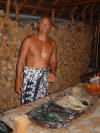  Another
evening, Manihi and Tila hosted a barbecue for all of us. Their place has
well-appointed thatched bungalows and would be a wonderful place to
really get away from it all. Tila decorates the place is amazing woven
palm fronds. Another
evening, Manihi and Tila hosted a barbecue for all of us. Their place has
well-appointed thatched bungalows and would be a wonderful place to
really get away from it all. Tila decorates the place is amazing woven
palm fronds.

Now we are
in the northern end of the same atoll, anchored off of the village of
Rotoava. We finally succeeded in having a meal in a local pension. I won’t
glamorize it by calling it a restaurant, but at least someone else cooked
it. We had some delicious poisson cru (a raw fish salad), grilled
fresh tuna, and apple tart for dessert.
 The owner
of same pension, Joachim, also has a pearl farm, so we did a bit more in
the pearl acquisition mode. We learn more about the process each time.
There were French guests at the pension, Papeete residents who said they
only buy pearls in the Tuamotus because they are so expensive in Papeete.
I love such reassurance for what seems totally decadent. Joachim told us
all about the three-times-a-year pearl auctions in Tahiti, organized by
the cooperative the farm owners all belong to. Must be amazing to see
thousands of top quality pearls worth millions in one place at one time. The owner
of same pension, Joachim, also has a pearl farm, so we did a bit more in
the pearl acquisition mode. We learn more about the process each time.
There were French guests at the pension, Papeete residents who said they
only buy pearls in the Tuamotus because they are so expensive in Papeete.
I love such reassurance for what seems totally decadent. Joachim told us
all about the three-times-a-year pearl auctions in Tahiti, organized by
the cooperative the farm owners all belong to. Must be amazing to see
thousands of top quality pearls worth millions in one place at one time.
Diving the passes
Jan has
been scuba diving every day with the dive shop based in this little town.
An amazing number of people fly in just to dive the famous pass. Jan did
two prep dives on the reef, which he enjoyed – lots and lots of big fish,
bigger than on most of the reefs. It seems there’s such a concentration of
nutrients in the swift water flowing through the passes that the coral is
more abundant, the fish are larger, and there are lots more predators:
barracuda, napoleon wrasses, moray eels, pelagic fish like tuna, and . . .
sharks. Then he did two drift dives in the pass – that’s when you drift
through on the incoming tidal current –at about 100 feet, seeing several
schools of 5 to 7 foot sharks of all types. For some reason, he claims
this was not scary, but he does admit to a certain frisson on
occasion! Like when Serge, the French divemaster, released the air-filled
buoy to the surface and a dozen large sharks shot up to investigate
whether it was edible. Prudently, Jan and Serge waited until the sharks
lost interest before they rose to the surface.
He also
dove on the south pass, which is much smaller and closer, and the cruisers
can do it without big support boats. Jan went out the other day with six
other divers in two inflatable dinghies, and they just plopped themselves
right into the pass and drifted in with the current. Not so many fish and
sharks, but still magnificent.
Tomorrow
morning we will raise the anchor and do an overnight passage to the
Society Islands, making landfall on the southern coast of Tahiti. We will
stay there for about a week until we hit La Grande Ville, Papeete.
Previous
log
Next log
This page was last
updated on
04/13/04. |